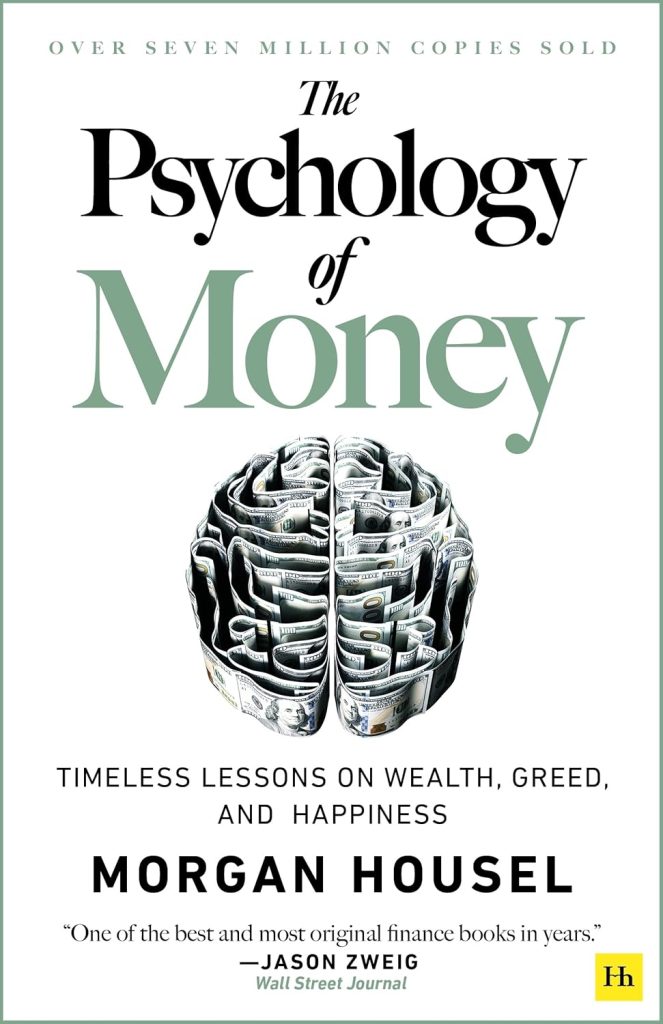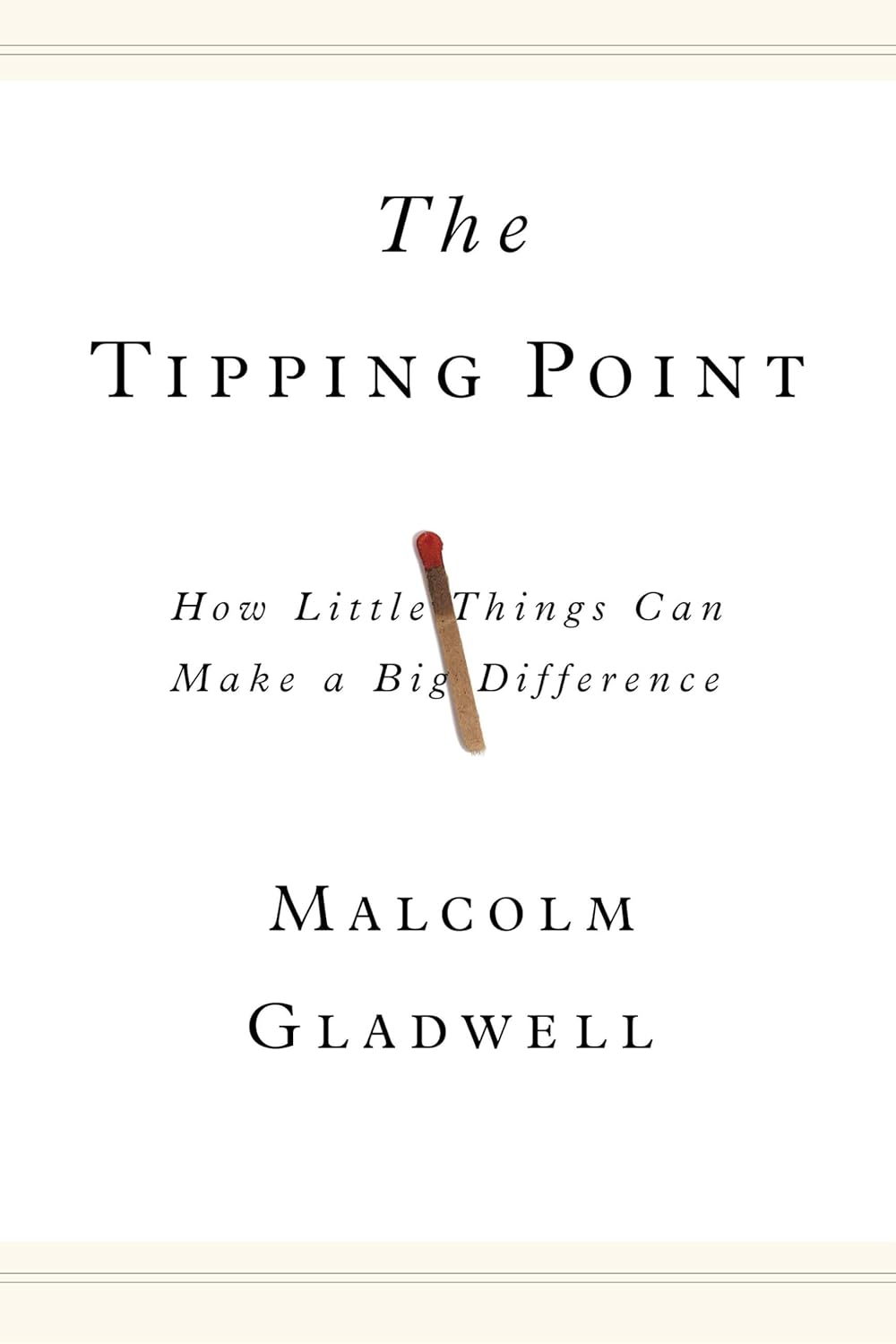
Buy The Book
Chapter
- ✦ Introduction
- ✦ 1. No One’s Crazy
- ✦ 2. Luck & Risk
- ✦ 3. Never Enough
- ✦ 4. Confounding Compounding
- ✦ 5. Getting Wealthy vs. Staying Wealthy
- ✦ 6. Tails, You Win
- ✦ 7. Freedom
- ✦ 8. Man in the Car Paradox
- ✦ 9. Wealth is What You Don’t See
- ✦ 10. Save Money
- ✦ 11. Reasonable > Rational
- ✦ 12. Surprise!
- ✦ 13. Room for Error
- ✦ 14. You’ll Change
- ✦ 15. Nothing’s Free
- ✦ 16. You & Me
- ✦ 17. The Seduction of Pessimism
- ✦ 18. When You’ll Believe Anything
- ✦ 19. All Together Now
- ✦ 20. Confessions
The Psychology of Money

About
Morgan Housel, a partner at Collaborative Fund and a former columnist for The Motley Fool, is a celebrated author known for his insights into behavioral finance. His book, *The Psychology of Money*, published in 2020, explores the complex relationship between people and money, emphasizing that financial success is less about knowledge and more about behavior.
In this engaging work, Housel presents 20 short chapters filled with anecdotes and lessons that challenge conventional financial wisdom. He discusses themes such as the impact of luck and risk, the importance of patience in investing, and the often-overlooked emotional aspects of financial decisions. Housel argues that understanding one’s own psychology is crucial for making sound financial choices. By illustrating how personal experiences shape our views on wealth, he encourages readers to adopt a long-term perspective and recognize the significance of behavior over mere technical knowledge. This book has resonated with a wide audience, making it a must-read for anyone interested in personal finance.

Spark
Learn
Review
✦ Introduction
Personal experiences forge financial logic. Consider Ronald Read, a janitor who saved modestly and invested in blue-chip stocks, eventually amassing millions. Contrast that with Richard Fuscone, a Harvard-educated executive who lost everything through high-risk leverage. Both made choices that seemed natural to their worldviews. Read, shaped by frugality and patience, couldn’t fathom Fuscone’s risks. Fuscone, raised amidst ambition, saw leverage as routine.
Different eras taught different lessons. Those who experienced inflation might hoard cash; those raised in stable times embrace stocks. A low-income family spending on lottery tickets? To outsiders it seems irrational, but for them, it’s purchasing hope when traditional paths feel unattainable. Every decision is rooted in personal history.
Financial behavior isn’t driven by IQ—it’s shaped by the unique incentives and fears imprinted by one’s past. A Depression-era retiree avoids markets not from ignorance but trauma. A 1990s tech worker trusts stocks because they’ve never seen a crash. Labeling these choices as “crazy” ignores the truth: our money habits are logical responses to the unique worlds we’ve lived in. Understanding this builds empathy, revealing that financial success hinges less on intelligence and more on the quiet influence of lived experience.
✦ 1. No One’s Crazy
Financial decisions are shaped by personal experiences, not inherent logic. The text illustrates how differing backgrounds—like growing up in poverty versus wealth—lead to wildly contrasting views on risk and reward. Ronald Read, a janitor who amassed millions through frugality and patient investing, contrasts with Richard Fuscone, an Ivy League-educated financier who lost everything through reckless borrowing. These examples highlight a key truth: financial success hinges more on behavior and circumstance than formal education or intelligence.
Individuals absorb distinct lessons from their unique slice of history—survivors of economic crises may avoid stocks, while those raised in prosperity embrace them. A low-income family buying lottery tickets, for instance, might prioritize fleeting hope over long-term planning. Such choices aren’t “crazy” but rooted in their lived reality, where traditional wealth-building feels unattainable. What seems irrational is often a rational response to personal constraints. Recognizing this fosters empathy and underscores that no one operates outside the context of their own history. Financial behavior reflects a mosaic of individual lessons, risk tolerances, and incentives—variables that defy universal rules. Understanding this complexity encourages humility when judging others’ choices and reshapes how we approach our own financial decisions.
✦ 2. Luck & Risk
Financial outcomes hinge not just on skill, but on forces beyond control. Consider Bill Gates, who attended a high school with early computer access—a stroke of luck. His path intersected with Paul Allen, leading to Microsoft’s rise. Yet Gates’ childhood friend Kent Evans died in a climbing accident before graduating, struck by the same random forces. Both highlight how a single twist of fate can tip success or tragedy.
In finance, wealth often stems from ventures that could easily have failed if circumstances shifted. A bull market genius might be a bear market casualty. Conversely, failures labeled as poor decisions may simply reflect unavoidable risks. Recognizing this balance fosters humility: success isn’t purely earned, nor is failure entirely deserved.
The key takeaway? Embrace outcomes with nuance. What seems calculated is often chaotic, and judging others’ choices requires acknowledging that luck and risk silently steer every journey. This mindset tempers arrogance in victory and softens judgment in defeat.
✦ 3. Never Enough
Chasing limitless wealth often ends in downfall despite prior success. Rajat Gupta and Bernie Madoff, already worth hundreds of millions, risked everything—careers, freedom, reputations—to amass more, exposing a universal trap: the inability to define “enough.”
Three lessons emerge:
1. **Moving Goalposts** – Ambition outpaces satisfaction. Each achievement resets desires, fueling risk-taking. Capitalism thrives on envy, but constant comparison leads to misery.
2. **Social Poison** – Comparing wealth to others is a losing game; someone always has more. Like gambling, the only “win” is refusing to play.
3. **Protecting Essentials** – Reputation, freedom, relationships, and happiness are nonnegotiable. Risking these for extra zeros is never worth it.
The chapter argues that wealth’s true purpose is securing freedom and stability—not endless accumulation. By defining personal limits, we avoid the destructive greed that transforms rational goals into ruinous obsessions. “Enough” isn’t complacency; it’s recognizing when pursuit of more undermines what truly matters.
✦ 4. Confounding Compounding
Compounding’s power lies not in explosive growth but in endurance. Warren Buffett’s fortune exemplifies this: 99% of his wealth emerged after age 50, not solely from exceptional returns, but from starting young and holding investments for decades. Even brilliant investors like Jim Simons—who achieved staggering 66% annual returns—couldn’t compete with Buffett’s cumulative gains, as their careers lacked the same longevity.
The chapter contrasts this with the slow buildup of Earth’s ice ages, where tiny snow accumulations over millennia triggered continental glaciers. Similarly, technology’s exponential growth—like storage devices evolving from megabytes to terabytes—reveals how incremental gains snowball into revolutionary change.
Most underestimate compounding because linear thinking dominates: doubling a penny for a month astounds, yet persistent, modest returns often outpace fleeting high-risk bets. The key is recognizing that sustainable success relies less on flashy wins and more on avoiding irrecoverable losses. True wealth stems from time, not timing—steady, unbroken participation in growth, even when progress seems invisible. This demands patience and an acceptance that meaningful results emerge from allowing years, not days, to work their quiet magic.
✦ 5. Getting Wealthy vs. Staying Wealthy
Building wealth and preserving it demand opposing mindsets. The former thrives on risk-taking, optimism, and assertive bets—traits that fueled Jesse Livermore’s legendary market short during the 1929 crash. But Livermore later lost it all by ignoring sustainability. In contrast, staying wealthy demands paranoia: avoiding ruin, maintaining frugality, and rejecting leverage. Abraham Germansky’s tragic spiral after the same crash underscores how fragile success becomes without a margin of safety.
Warren Buffett’s secret isn’t just high returns—it’s endurance. Surviving recessions, resisting debt, and allowing decades of compounding turn modest gains into generational wealth. Many brilliant investors fail because their strategies prioritize short-term wins over long-term survival.
Key lessons:
1. **Risk tolerance flips**: Aggressive growth fuels wealth creation; humility and hedging preserve it.
2. **Avoid irreversible losses**: A single catastrophic misstep can erase years of gains.
3. **Time as the ultimate edge**: Compounding rewards those who stay in the game, unbroken by volatility.
Staying wealthy means accepting that avoiding disaster matters more than chasing maximum returns. Surviving uncertainty allows compounding to quietly work its magic.
✦ 6. Tails, You Win
Outsize success hinges on rare, unforeseeable “tail events”—a handful of wins overshadowing countless losses. Despite most outcomes falling flat, a few dominant triumphs drive results. Consider venture capital: 65% of investments fail, but 0.5% yield 50x returns, funding entire portfolios. Public markets mimic this: 40% of Russell 3000 companies collapse permanently, yet 7% generate nearly all market gains. Amazon and Apple exemplify how single innovations (Prime, iPhone) overshadow countless failed projects.
Investors like Berkshire Hathaway and art dealer Heinz Berggruen thrived by holding diverse portfolios long enough for outliers to emerge. Survival through volatility is key—persisting through inevitable failures allows compounding tails to work. Mediocre decisions dominate daily life, but responses during rare crises (2008 crash) shape long-term wealth.
For every Disney’s *Snow White*—turning 400 prior flops into irrelevance—success demands tolerance for failure. Few decisions matter critically; genius lies in staying calm when others panic. Recognize that most actions are unremarkable, but patience through setbacks lets explosive outliers define ultimate success.
✦ 7. Freedom
True wealth isn’t measured by money but by control over time—the freedom to live on your terms. Examples include professionals leaving high-paying jobs for flexible schedules, or retirees prioritizing autonomy over luxury. Financial independence means sustaining your lifestyle without relying on employers or obligations.
High-income earners chained to stressful roles often feel poorer than those with modest means who dictate their days. The goal shifts from chasing more money to preserving the ability to say, “I can do what I want, when I want.” This requires avoiding lifestyle inflation that traps you in endless earning cycles.
Retirees with purpose thrive not because of wealth but because their time is self-directed. Conversely, accumulating riches without autonomy becomes hollow. Freedom emerges when savings and investments provide resilience against life’s unpredictability. The ultimate luxury isn’t possessions—it’s waking up each day empowered to choose how your time is spent, unburdened by financial constraints or others’ demands. This redefines wealth as liberation from external control.
✦ 8. Man in the Car Paradox
Owning a luxury car signals wealth, but the admiration it garners is misplaced. Observers imagine themselves in the driver’s seat, envying the *idea* of wealth, not the person behind the wheel. The paradox: spending heavily to impress others backfires, as they focus on the asset, not its owner.
Examples abound: Warren Buffett still lives in his first home bought in 1958. CEOs of major companies drive modest cars. True wealth often hides in the background, emphasizing freedom and security over visible symbols. Those flaunting luxury risk sacrificing long-term stability for fleeting validation.
People conflate material displays with financial competence. A janitor like Ronald Read, quietly compounding savings, might be richer than a flashy executive buried in debt. The lesson? Status symbols can signal financial fragility rather than success. Admiration for possessions often reflects a misunderstanding of wealth—which resides in what isn’t spent, not what’s showcased.
The paradox reveals a deeper truth: genuine wealth is the ability to live unburdened by others’ perceptions, free from the need to prove anything through consumption. Striving to impress strangers often leads to sacrificing the very independence that real wealth affords.
✦ 9. Wealth is What You Don’t See
True wealth hides in silence. Consider a neighbor driving a luxury car: that purchase sacrificed savings that could compound into generational security. Wealth isn’t flashy cars, designer clothes, or Instagram vacations—it’s income *not* spent, investments quietly growing untouched. The wealthy often look like everyone else because their money fuels freedom, not status.
Stories contrast those who *appear* rich versus those who actually *are*. The former prioritize signaling success, risking debt and fragile finances. The latter sacrifice temporary indulgence for lasting security, knowing visible extravagance erodes opportunity. A modest home with a paid mortgage and a retirement account outpacing peers’ portfolios is more powerful than any status symbol.
Prestige tempts us to mimic affluent lifestyles, trading tomorrow’s independence for today’s admiration. But wealth’s true measure isn’t consumption—it’s optionality. Financial security means waking up debt-free and unshackled by others’ expectations. Those who prioritize stealth wealth build resilience; those chasing appearances risk trading their future for fleeting validation. The lesson? Real riches lie in what you *don’t* spend—and rarely show.
✦ 10. Save Money
The act of saving money isn’t merely about accumulating wealth; it’s fundamentally about creating choices and securing a stable future. Saving provides a safety net that allows for greater flexibility in life, enabling individuals to weather unexpected events without financial distress. It encourages a mindset of discipline and foresight, focusing on long-term goals rather than immediate gratifications.
Even modest, consistent savings can accumulate significantly over time due to the power of compounding. The chapter emphasizes that wealth should be viewed not just in terms of visible assets but also in the choices and alternatives available to you. Many who prioritize spending risk their future stability, trading long-term options for short-lived pleasures.
By fostering a habit of saving, individuals prepare themselves for life’s uncertainties, enabling them to make deliberate choices rather than being reactive to crises. Ultimately, the true essence of wealth lies in the freedom gained through adequate savings, allowing for a life defined by options rather than obligations.
✦ 11. Reasonable > Rational
Defining success with money necessitates balancing rationality with the understanding that human behavior is often less logical than it appears. Rational decisions might stem from the latest financial models and historic data, but applying these solely can lead to pitfalls. Behavioral finance reveals how emotions, personal experiences, and biases significantly influence money decisions.
For instance, a fear of loss can drive individuals to overly conservative investments, while greed might lead others to take excessive risks. Therefore, making reasonable choices based on one’s circumstances and comfort level often proves more beneficial than adhering strictly to rational strategies dictated by theory.
The narrative highlights that knowing what to do with money doesn’t guarantee success; effective financial behavior is driven by understanding oneself and one’s emotions. Recognizing that financial life is more about personal behavior than abstract calculations empowers individuals to navigate complexities. Thus, cultivating reasonable, flexible strategies that account for the unpredictability of human emotions can lead to more sustainable financial well-being.
✦ 12. Surprise!
The unpredictability of financial markets highlights the importance of being flexible and open to unexpected events. Factors that can disrupt plans or change paths often emerge when least anticipated. Historical data shows that markets can be volatile, driven by events that seem insignificant at the time. This uncertainty emphasizes that what appears to be a trend can suddenly shift, creating surprising outcomes.
Acknowledge that what works today may not work tomorrow. The past offers lessons, but it doesn’t dictate future results. Great investors aren’t those who can predict every market turn, but those who can adapt and respond to surprises.
Examples abound: some investors thrived by adjusting strategies in response to unforeseen challenges. Meanwhile, others who stubbornly clung to rigid plans encountered significant setbacks. This chapter encourages a mindset that embraces surprise as a natural part of investing, urging the recognition that flexibility and preparedness are essential traits in navigating the unpredictable landscape of finance.
✦ 13. Room for Error
Creating a successful financial strategy requires acknowledging that things often don’t go as planned. Life is unpredictable, and leaving room for error is essential in managing money effectively. Having a safety margin helps protect against unexpected downturns or mistakes, allowing for adaptability in the face of uncertainty.
For example, a solid financial plan should incorporate potential risks and the reality that markets can fluctuate. The ability to pivot when things go awry can be more valuable than precise calculations. Investing too heavily without safety nets can lead to catastrophic losses.
The chapter highlights that history is replete with stories of individuals who failed due to lack of flexibility or overconfidence in their abilities. Adopting a mindset that embraces uncertainty while preparing for possible setbacks fosters resilience and long-term success. By recognizing that not every outcome can be controlled, one can build a more sustainable approach to wealth that prioritizes survival and adaptability over short-term gains.
✦ 14. You’ll Change
Financial goals and values often shift over time, reflecting changes in life circumstances and personal development. Decisions made in youth may not align with future needs or desires. The formative experiences that shape our approaches to money are not static; they evolve as life unfolds. At 20, financial choices might revolve around living expenses and travel. By 40, priorities may shift toward saving for children’s education or retirement.
Past experiences influence current views, leading to potential contradictions in beliefs about wealth and success. A person who once valued high-risk investments may later prioritize stability and security after experiencing volatility.
Acknowledge that changing perspectives are not failures but necessary adaptations to evolving life stages. Embracing the idea that what seems right now may not hold true later allows for greater flexibility in financial planning. Understanding this fluidity helps navigate future challenges, reinforcing the principle that adapting to change is vital for long-term financial well-being and personal growth in handling money.
✦ 15. Nothing’s Free
Every financial decision comes with a cost, and nothing is truly free. When someone offers something seemingly without charge, there’s usually a hidden price tag. This concept can apply to everything from interest-free loans to “no cost” services—nothing is without strings attached.
For example, the allure of seemingly free perks can draw people in, but the underlying costs, whether in terms of time, effort, or future obligations, are often overlooked. This creates a cycle where individuals become entangled in unnecessary commitments or debts, chasing after immediate gratification without considering long-term consequences.
Those who understand that nothing is free can make more informed decisions. They can appreciate the true value of what they are receiving and weigh it against what they must ultimately give up. Recognizing the hidden costs associated with financial choices leads to wiser spending habits and a healthier approach to wealth management, emphasizing the importance of vigilance and critical thinking in all financial dealings.
✦ 16. You & Me
Understanding financial behavior hinges on recognizing how personal experiences shape our perspectives on money. Each person’s unique history informs their decisions, leading to diverse beliefs about risk, reward, and financial strategies. For instance, someone raised in wealth may view investments differently than someone from a modest background, leading to contrasting attitudes towards spending and saving.
Financial decisions are often driven by emotions and past experiences rather than purely rational analysis. This discrepancy can cause misunderstandings between individuals with varying backgrounds. The importance of empathy in financial discussions cannot be overstated; acknowledging that what seems irrational to one person may be a rational choice for another fosters better communication.
Ultimately, we build our financial identities through a blend of knowledge, experience, and the narratives we construct around money. Recognizing these differences can help create a more supportive environment for discussing personal finance, leading to more informed and thoughtful decision-making.
✦ 17. The Seduction of Pessimism
Pessimism can be alluring, especially when faced with uncertainty, as it often seems more realistic than optimism. The human mind tends to focus on negative outcomes, interpreting risks with a bias that can lead to inaction or overly cautious decisions. This mindset can distort reality, making pessimism appear to be a safe refuge.
When confronted with investment opportunities or financial decisions, this tendency might result in hesitation or a propensity to avoid risk altogether. However, over time, this cautious approach can hinder financial growth and limit potential gains. It’s essential to recognize the balance between acknowledging risks and maintaining a forward-looking perspective. Understanding that while negative outcomes are possible, they are often accompanied by equally significant opportunities can help navigate the complexities of financial decision-making. Embracing a more balanced outlook, one that appreciates both risk and reward, can ultimately lead to better financial outcomes.
✦ 18. When You’ll Believe Anything
Believing in the improbable becomes easier in times of uncertainty, especially in financial contexts. The mind has a tendency to latch onto narratives that offer comfort or validation, particularly when faced with ambiguous situations. This can lead to the acceptance of dubious claims or trends that promise quick wealth or security.
The allure of quick fixes often blinds individuals to the reality of financial situations, encouraging reckless decision-making. People gravitate towards stories and ideas that resonate with their emotions rather than those grounded in logic and facts. This belief can be particularly dangerous in investing, where it can lead to impulsive decisions based on hype rather than sound analysis.
Ultimately, fostering a skeptical mindset and relying on critical thinking can help navigate the complex world of finance. Embracing uncertainty and recognizing that not everything is as it seems allows for more informed financial decisions, reducing the risk of falling prey to misinformation.
✦ 19. All Together Now
The shared understanding of money is shaped by our individual experiences, which vary widely across generations, backgrounds, and cultures. These differences contribute to how we perceive financial risks and rewards. As a result, what seems irrational to one person might be completely sensible to another, deeply influenced by personal histories and socioeconomic contexts.
This chapter emphasizes the importance of acknowledging that no one’s financial behavior is purely driven by logic or education. Our decisions are often tinged with emotions and shaped by our unique narratives. This diversity in perspectives can lead to conflict in financial discussions, as individuals may struggle to understand opposing viewpoints.
Ultimately, recognizing and appreciating these varied experiences can foster better communication and collaboration in financial matters. Understanding that everyone comes to the table with different fears, hopes, and lessons learned allows for richer, more empathetic discussions about money and its role in our lives.
✦ 20. Confessions
Acknowledging personal flaws and missteps in financial decision-making is essential. There’s a deep reality that even those deemed financially savvy can fall victim to irrational behavior. Often, success in finance is less about intelligence and more about the psychological factors that drive decisions.
Recognizing the unpredictable nature of luck and risk highlights how individual experiences shape understanding and behavior regarding money. Acknowledging these influences can foster humility and promote better decision-making.
Self-awareness is crucial; sharing failures can be enlightening, revealing that even the most educated individuals can succumb to emotional impulses or societal pressures.
Ultimately, embracing the unpredictable aspects of finance allows for a more nuanced view of wealth building. Recognizing that everyone is influenced by their unique narratives encourages empathy towards others’ financial choices, fostering a supportive community that prioritizes understanding over judgment in the often chaotic world of personal finance.
For People
– Individual investors seeking to improve their financial decision-making
– Financial professionals looking to understand behavioral finance
– Students of economics or finance interested in the psychological aspects of money
– Anyone struggling with their personal finance habits and mindset
– Readers interested in self-improvement and personal development related to wealth
Learn to
– Gain insights into the emotional factors that influence financial decisions
– Learn the importance of patience and long-term thinking in investing
– Understand how personal experiences shape one’s relationship with money
– Develop a healthier mindset towards wealth and financial success
– Discover strategies to avoid common pitfalls and improve financial behaviors









